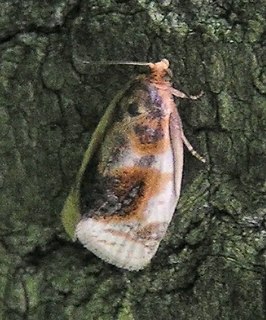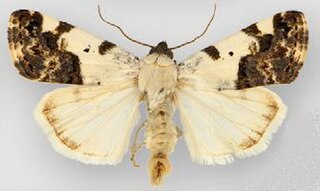
Erinnyis lassauxii, or Lassaux's sphinx, is a moth of the family Sphingidae.

Leptarctia is a monotypic tiger moth genus in the family Erebidae described by Stretch in 1872. Its only species, Leptarctia californiae, was described by Francis Walker in 1855. It is found in western North America, from New Mexico and Colorado to California and north to British Columbia. The habitat consists of open forests, meadows and clearings in the mountains.

Clepsis melaleucana, the black-patched clepsis, is a moth of the family Tortricidae. The species was first described by Francis Walker in 1863. It is found in North America from Alberta to Newfoundland, south to North Carolina and Missouri.

Anarta myrtilli, the beautiful yellow underwing, is a moth in the family Noctuidae. The species was first described by Carl Linnaeus in 1761. It is found in most of Europe including Scandinavia, Britain, France, Germany, Switzerland, Spain, Portugal, Italy, and Russia.

Tarache aprica, the exposed bird dropping moth, is a moth of the family Noctuidae. The species was first described by Jacob Hübner in 1808. It is found in North America from Ontario and Quebec to Florida, west to Arizona, north to Kansas and Iowa. There are some records from Great Britain, but this probably relates to imports.

Xylophanes germen is a moth of the family Sphingidae. It is known from Mexico, Costa Rica, Guatemala and is found from Venezuela to Bolivia.
Adela ridingsella, Ridings' fairy moth, is a moth of the Adelidae family or fairy longhorn moths. It was described by James Brackenridge Clemens in 1864. It is widespread in eastern North America, from Nova Scotia, Ontario, Quebec and Maine to Pennsylvania and the mountains of North Carolina.
Eupithecia segregata is a moth in the family Geometridae first described by Pearsall in 1910. It is found in the US states of Oregon, Arizona and California.
Eupithecia subapicata is a moth in the family Geometridae first described by Achille Guenée in 1857. It is found in the western United States from California through Oregon to Washington.
Pyrausta pythialis is a moth in the family Crambidae. It was described by William Barnes and James Halliday McDunnough in 1918. It is found in North America, where it has been recorded from Manitoba and Saskatchewan.
Acleris busckana is a species of moth of the family Tortricidae. It is found in North America, where it has been recorded from Maine, Manitoba, Massachusetts, New Brunswick, New Hampshire, Ohio, Ontario, Quebec and West Virginia.
Acleris nivisellana, the snowy-shouldered acleris moth, is a species of moth of the family Tortricidae. It is found in North America, where it has been recorded from southern Canada and the northern United States, south in the east to Maryland and Virginia, south in the west to California.

Philonome clemensella is a species of moth of the family Tineidae found in North America.
Scoparia rigidalis is a moth in the family Crambidae. It was described by William Barnes and James Halliday McDunnough in 1912. It is found in North America, where it has been recorded from Arizona.
Cliniodes mellalis is a moth in the family Crambidae. It was described by James E. Hayden in 2011. It is found in Costa Rica.
Choristostigma disputalis is a moth in the family Crambidae. It was described by William Barnes and James Halliday McDunnough in 1917. It is found in North America, where it has been recorded from Alberta, Arizona, British Columbia, California and Oregon.

Eucosma dorsisignatana, the triangle-backed eucosma, is a species of moth of the family Tortricidae. It is found in North America, where it has been recorded from Nova Scotia to Florida, west to Texas and north to Manitoba.
Dalcerina tijucana is a moth in the family Dalceridae, and the only species in the genus Dalcerina. It was described by Schaus in 1892. It is found in Panama, eastern Peru, Brazil, Paraguay and northern Argentina. The habitat consists of tropical wet, tropical moist, tropical premontane moist, subtropical wet, subtropical moist, subtropical dry, subtropical lower montane moist and warm temperate moist forests.
Dichomeris siren, the least dichomeris moth, is a moth in the family Gelechiidae. It was described by Ronald W. Hodges in 1986. It is found in the United States, where it has been recorded from Maryland, Connecticut, Indiana, Michigan, New Jersey, Virginia, South Carolina, Tennessee and Georgia.
Dichomeris ochripalpella, the shining dichomeris moth, is a moth in the family Gelechiidae. It was described by Philipp Christoph Zeller in 1873. It is found in North America, where it has been recorded from southern Quebec and southern Ontario to New Jersey, North Carolina and Arkansas.








